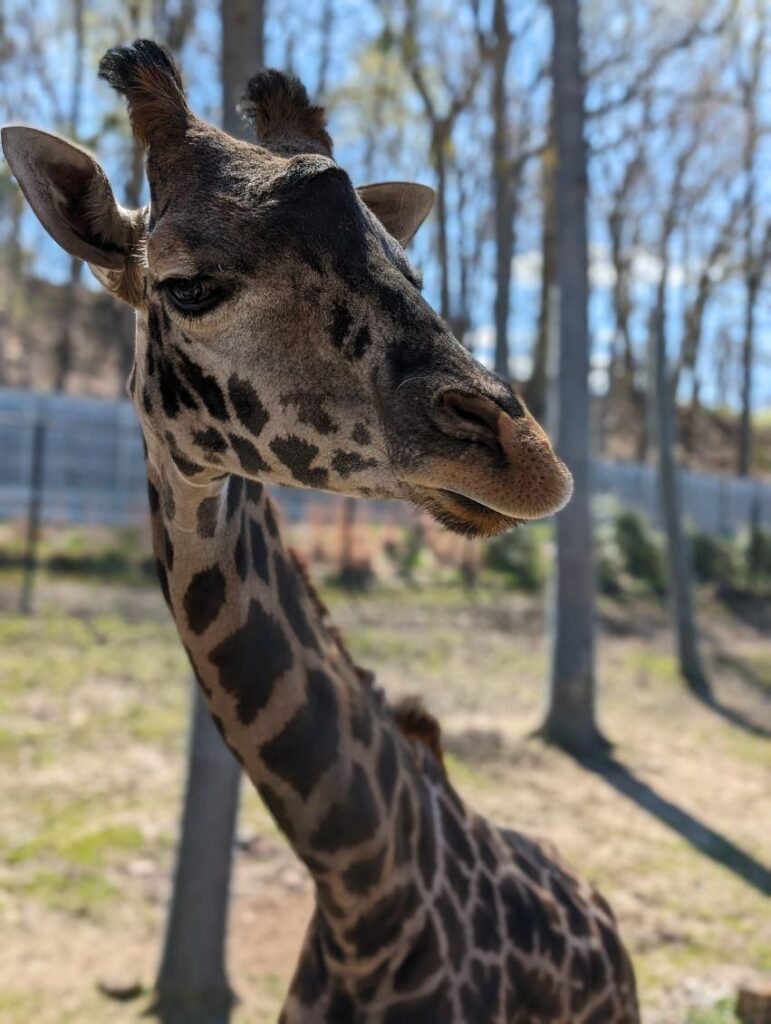
If you’d like to see eye-to-eye, you better grab a ladder—with their heads soaring up to eighteen feet off the ground, they’re the tallest land animals in the world but weigh less than a rhino. Any guesses? They’re easy to spot! And have lots of spots . . .
The Seneca Park Zoo is home to four Masai giraffes— JD, a three-year-old male; Iggy, a seven-year-old female; and her two calves, Olmy, a two-year-old male, and Pippi, a female who turns one in December. They’re native to East Africa and are the national animal of Tanzania.
Maggie Kinsella, a zookeeper at the Seneca Park Zoo, explains that while giraffes are very tall, they weigh less than one might think. A fully grown adult male giraffe will weigh around 2,500 pounds. In comparison, the zoo’s rhino weighs around 4,400 pounds.
“They’re very stretched out—a small adult female giraffe could weigh the same as a big horse,” Kinsella says.
Iggy is the only adult of the tower—that’s the term for a group of giraffes—that has finished growing, standing about fourteen feet tall.
“They usually finish growing when they’re about seven,” Kinsella says. “And their ossicones, which are the little horns on top of their heads, will be fused to their skulls at that age. The ossicones start off as cartilage and turn to bone as the giraffes get older.”
Aside from height and weight, a key difference between male and female giraffes is their ossicones.
“The ossicones on male giraffes will be balder on top; they won’t have as much hair or the cute little tops that females generally have,” Kinsella says. “Males also have a median lump on their face, which is kind of what it sounds like—a big lump right along the bridge of their nose. As they get older, more calcium gets deposited on that lump, making it bigger. They also develop other little calcium bumps on their face, making their skulls heavier. Males use their heads and ossicones to compete for females. So, an older male will have a better chance at winning a fight because as he ages, his skull gets heavier with the extra calcium.”
But what about their personalities? Giraffes are a very friendly, nonaggressive species. In terms of fight or flight, they’re flight—if anything is even remotely scary, they’re usually going to run away from it.
“They live in big herds out in the wild, but they’re not really territorial. They won’t fight over space, and it’s very easy to introduce giraffes to each other. They’ll smell each other, and then they’ll be friends,” Kinsella says.

Kinsella explains how giraffes aren’t necessarily active animals and tend to wander around. The four giraffes at the zoo, however, get a lot of enrichment during the day to keep them busy.
“We have a bunch of different toys that we fill with hay, lettuce, and treats, and we’ll hang those up at different heights for them. We also use a bunch of different smells— we’ll spray perfume on things or sprinkle spices around for them,” Kinsella says.
Their training sessions are primarily focused on learning simple actions that help with veterinary tasks. And while giraffes are very sweet animals, they take longer to train than some of the other animals at the zoo.
“They’re all trained to stand on our scale so we can weigh them, and we do that once a week or so,” Kinsella says. “They are injection trained; Iggy and Olmy are both trained for foot care—they’ll put a foot up on a block and let someone file their hoof. Iggy is trained to let us take blood from her, and they are all target trained. We take target poles, and wherever we put them, they’ll touch with their nose and get a treat. We use that to help move them around the exhibit and explore.”
One exception to the veterinary-based training, however, is a special talent the zookeepers taught Olmy last year— how to paint.
“We have a special made easel and a big tennis ball hanging from a rope, and there’s a hole in the bottom of the ball that we put a paintbrush inside. We dip the brush in paint, and Olmy moves the tennis ball with his nose, dragging the brush on a canvas and making really cute paintings,” Kinsella says.
Some of Olmy’s paintings are sold in the gift shop at the zoo, and a lot are sold through the zoo’s AAZK chapter (American Association of Zoo Keepers). All the proceeds from those paintings go back to the animals.
Giraffes are herbivores, and a feature that helps them eat all different kinds of plants is their tongue.
“In the wild, giraffes eat a lot of acacia trees,” Kinsella says. “They have really big thorns that can be three inches long, and that’s part of the reason why giraffes have this super long, sticky tongue. Their tongues are about eighteen inches long, and along with their lips, they’re prehensile, meaning they function like a hand. They can twist their tongues around branches and pick up twigs, and they use it to carefully pick leaves off spiky trees; the blackish purple color acts as a natural sunscreen.”
Their diet at the zoo mimics what they would eat in the wild and mainly consists of hay. They eat three different kinds of hay, varying amounts of giraffe grain, and different produce.
“They really like lettuce and kale; sometimes we’ll offer them broccoli, bell peppers, or parsnips, and they really like carrots. We offer them big branches and sticks, and they’ll mainly eat leaves, but they like willow branches and some of the smaller willow shoots,” Kinsella says. “They’ll have access to their hay all day, but they only eat when they’re hungry, and they get a breakfast, lunch, and dinner.”
Giraffes typically live into their teens, but there have been some that live into their twenties or even reach thirty; and while there is a relatively stable population of giraffes, they are endangered. Like many animals, their main predator is humans. “There are a lot of ways to help the giraffes even though we don’t live around them in the wild,” Kinsella says.
“There are organizations you can get involved in to help support them—the Giraffe Conservation Foundation and Save Giraffes Now are two. Locally, the zoo is a great place to learn more about them and other ways you can help.”
Views: 36






